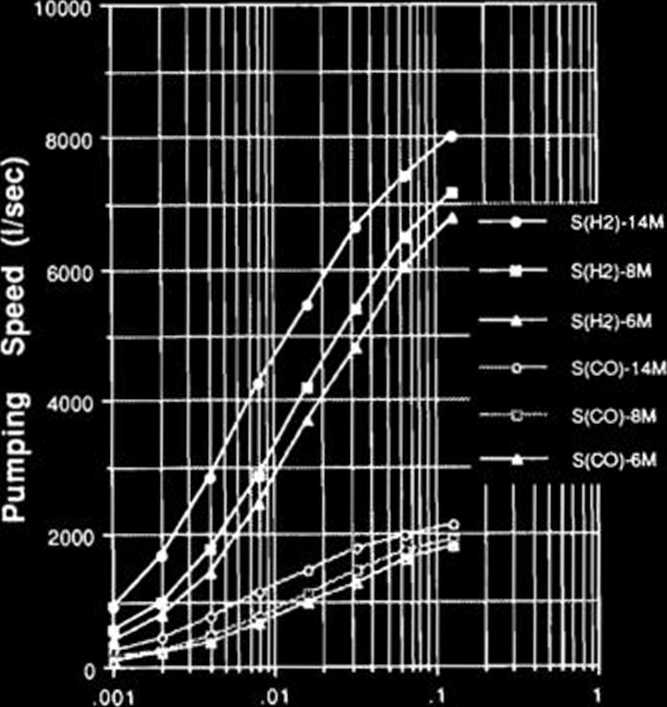372596182
RIKEN Accel. Próg. Rep. 24 (1990)
V-2-24. Monte Carlo Simulation in the LNP Structure
S.R. In,1 T. Wada, and S.H. Be
Three types of non-evaporable getters (NEG’s), i.e., a NEG strip, NEG wafer module, and lumped NEG pump (LNP) comprising several NEG wafer modules, have distinct pumping charatceristics even though they are madę of the same materiał. If we know geometrical influences of the NEG cofigura-tions, we can accurately estimate the pumping speed of a specified pump structure, using known sticking coefficients as universal parameters. A dis-tributed pump model and Monte Carlo simulation are generally used to solve such a problem.
The pumping speed is expressed as a multiplica-tion of a pumping probability at the top piane and an orifice conductance of the pump entrance port. The pumping probability depends on the sticking coefficient of NEG and the practical geometry of the whole pump system. The Monte Carlo method is an effective tool of calculating the pumping probability. In a Monte Carlo program diffuse reflections and sticking probabilities are treated as random pro-cesses. The pumping probability is obtained as a

Sticking Coefficient
Fig. 1. Calculated pumping speeds of the LNPs with dif-ferent configurations for H2 and CO as a function of the sticking coefficient.
ratio of the total counts of absorption to the total counts of incidence of test particles.
Figurę 1 shows the pumping speed of the LNP for II2 and CO calculated as a function of the sticking coefficient. By comparing with typical experi-mental data of the pumping speed, the sticking coefficients of NEG used in the LNP are roughly estimated at 0.004 for H2 and 0.03 for CO. The sticking coefficient for H2 was directly measured in the experiment of the equilibrium characteristics of the LNP1} to be about 0.004. This indicates that the calculating model used and the experimental condi-tions are consistent with each other. A few exam-ples of the pumping speeds calculated for different configurations of the NEG modules in the LNP are also shown in Fig. 1. Because the conductances to the pumping port are almost the same for all the configurations, the pumping speeds of the LNP are not linearly proportional to the number of NEG modules used in the LNP, especially for heavy molecules. The pumping speeds of the LNP with 6 NEG modules for H2 and CO are about 50% and 70% of those with 14 NEG modules.
The intrinsic pumping speed of a pump is defined as the pumping speed measured with a test chamber of infinite size. In a Monte Carlo calcula-tion such a situation is easily prepared, but actual pumping speeds can not be measured without using a test chamber of finite size. The difference be-tween the two chambers is in the degree of random for the incident directions of gas particles. An aver-age cosine for the chamber of finite size is larger than 1/4, indicating that the particles incident upon the pumping port prefer the forward direction. The Monte Carlo simulation shows that the pumping speed must be measured at the position above the entrance piane of the pump. The influence of the orifice diameter is not elear yet.
References
1) S.R. In, T. Maruyama, and S.H. Be: This Report, p. 179.
On leave from KAERI, Dajeon, Korea.
Wyszukiwarka
Podobne podstrony:
92 RIKEN Accel. Próg. Rep. 24 (1990)111-5. Instrumentation1. Design of a Microbeamline for a Compact
94 RIKEN Accel. Próg. Rep. 24 (1990)111-5-2. Design of a Decay Muon Channel Using an Axially Symmetr
102 RIKEN Accel Próg. Rep. 24 (1990)111-5-8. Performance of Isotopic Separation in RIPS T.Nakamura,
103 RIKEN Accel. Próg. Rep. 24 (1990)111-5-9. Test Experiment of the GARIS/IGISOL K. Morita, T. Nomu
105 RIKEN Accel. Próg. Rep. 24 (1990)111-5-10. Velocity Distribution of IGISOL lon Beams M. Koizumi,
108 RIKEN Accel. Próg. Rep. 24 (1990)111-5-12. Status Report of the RIKEN Swinger-Magnetic Analyzer
110 RIKEN Accel. Próg. Rep. 24 (1990)111-5-14. Test for Dispersive-Mode Beam Transportto the SMART
116 RIKEN Accel. Próg. Rep. 24 (1990)111-5-19. Responses of Large Position-Sensitive Detectorsto Hea
121 RIKEN Accel. Próg. Rep. 24 (1990)IM-5-23. A Test for SMART Neutron Detectors H. Orihara, K. Hata
RIKEN Accel. Próg. Rep. 24 (1990)111-5-25. High Speed Serial Data Link for PC-9801 J. Fujita > PC
129 RIKEN Accel. Próg. Rep. 24 (1990)IV-2. Cross Section Data for 68Ge ProductionY. Tendow, A. Hashi
132 RIKEN Accel. Próg. Rep. 24 (1990)IV-5. Cross Sections Calculated by an ALICE Codęin the A = 50 —
133 RIKEN Accel. Próg. Rep. 24 (1990)V. DEVELOPMENT OF ACCELERATOR FACILITIES1. lon Accelerator Deve
138 RIKEN Accel. Próg. Rep. 24 (1990)V-l-4. RIKEN (Japan)-RAL (U.K.) Collaboration on Muon Science R
5 RIKEN Accel. Próg. Rep. 24 (1990)11-2. RILAC Operation Y. Chiba, M. Hemmi, M. Yanokura, M. Kasę, E
158 RIKEN Accel. Próg. Rep. 24 (1990)V-2-ll. Bump Magnet of SPring-8 H. Miyade, H. Takebe, and S. Mo
160 RIKEN Accel. Próg. Rep. 24 (1990)V-2-12. Measurement of a 508 MHz Model Coupler forthe SPring-8
168 RIKEN Accel. Próg. Rep. 24 (1990)V-2-16. All-Metal Gate Valve with an RF Contact S. Yokouchi, K.
więcej podobnych podstron